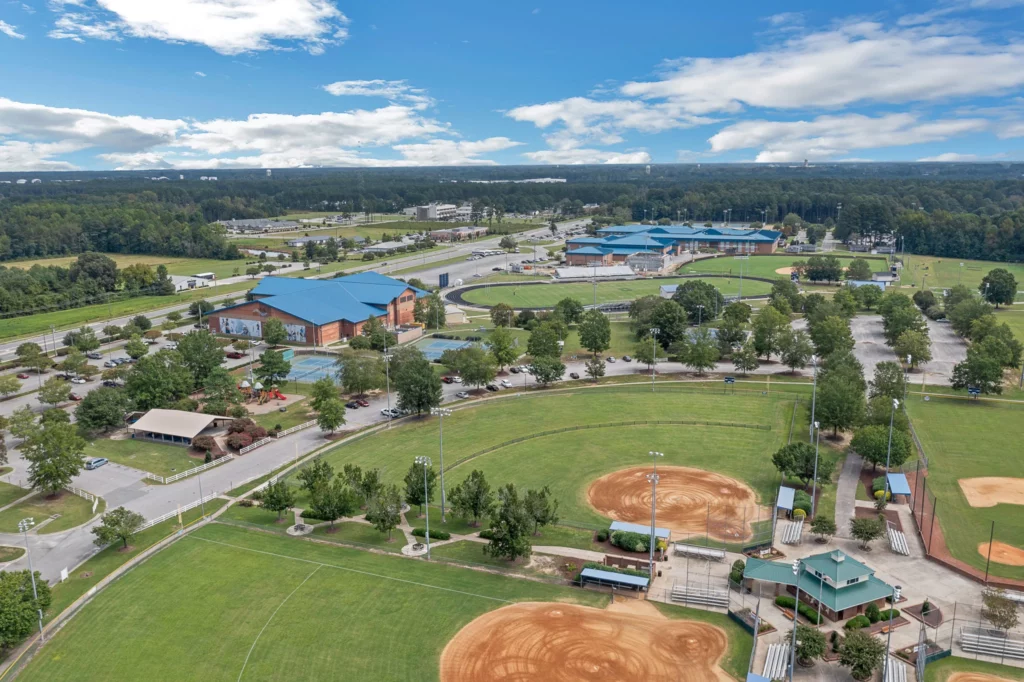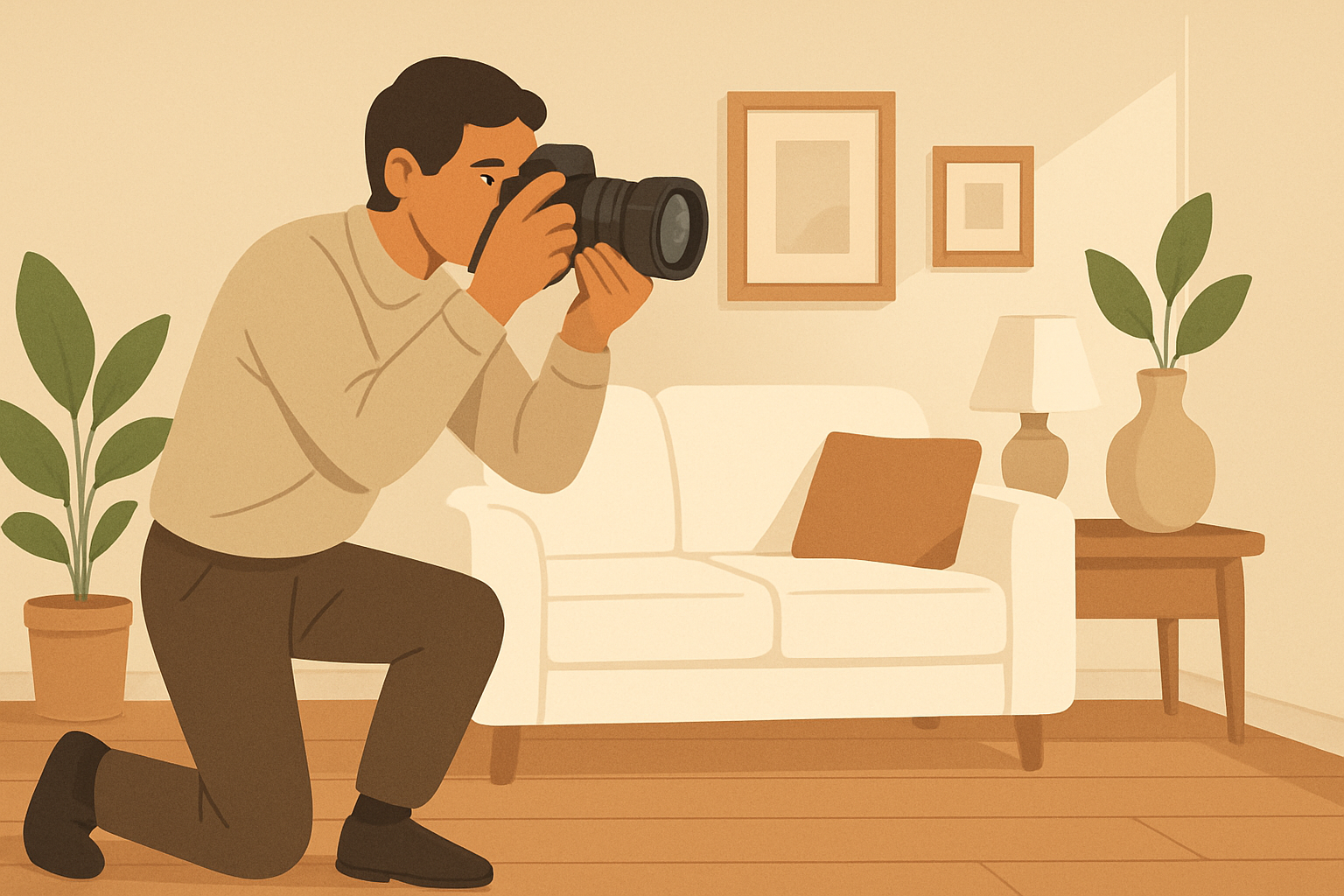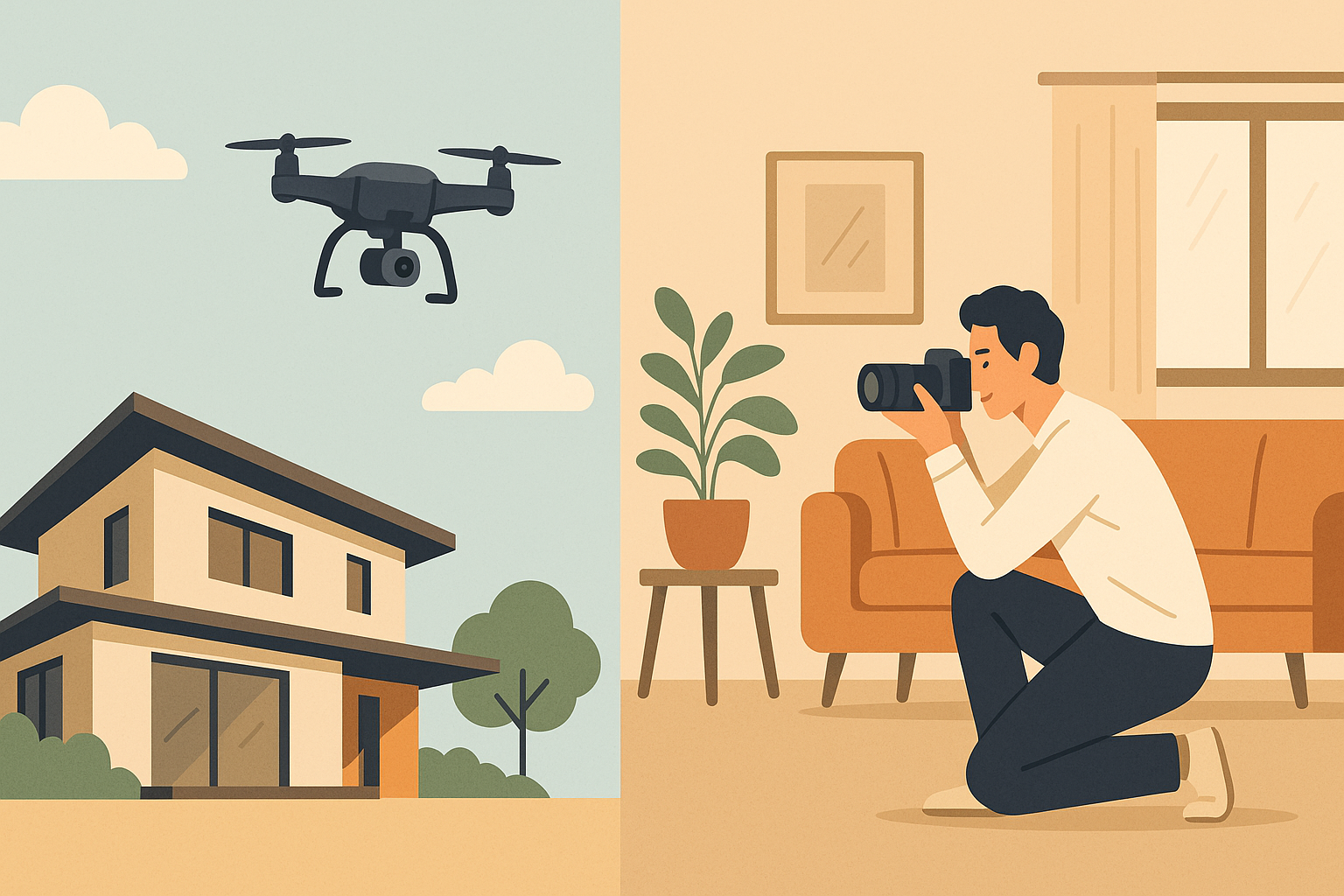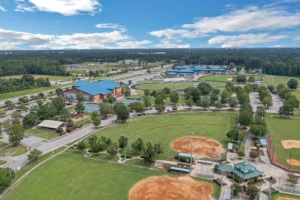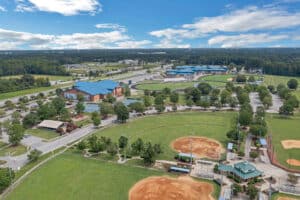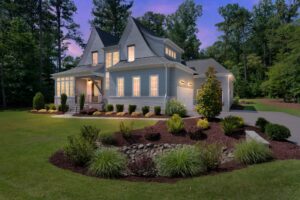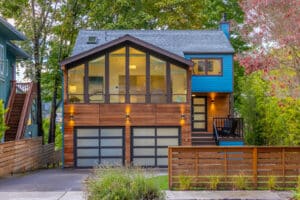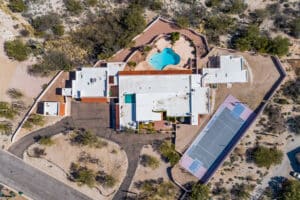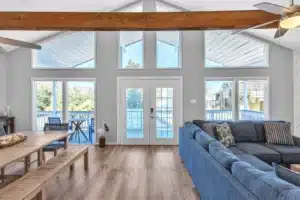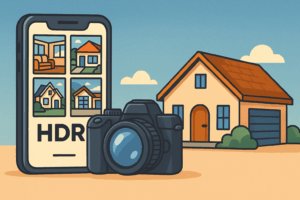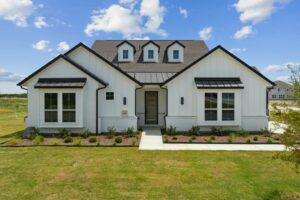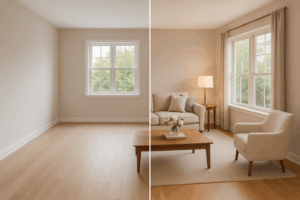Drone photography is transforming real estate marketing. Listings with aerial images sell 68% faster and get 94% more views compared to those without. Buyers are drawn to visuals that showcase not only the property but also its surroundings, making drone imagery a standout tool. Meanwhile, standard photography remains essential for highlighting interior details and creating an emotional connection with potential buyers. Combining both methods ensures a complete property presentation, helping agents attract more interest and close deals more effectively. Platforms like HomeJab offer services that integrate both aerial and interior photography for maximum impact.
5 Essential Drone Shots for Real Estate Drone Videos
1. Drone Photography
Drone photography has reshaped how properties are showcased, offering perspectives that were once impossible to capture. In 2024, an impressive 35% of realtors have adopted drones to market their listings, highlighting the growing reliance on this technology in the real estate world.
Architectural Detail Showcase
Drones excel at revealing architectural details that traditional cameras often miss. Unlike ground-level photography, which can struggle to capture the scale and intricacies of taller buildings or larger structures, drones can hover at the perfect height and angle to showcase the entire architectural story.
This technology brings unique elements into focus – like distinctive rooflines or solar panels – that are often overlooked in conventional shots. While traditional photography might only provide fragmented views, drones offer a complete and cohesive representation of a property’s design.
“Trained architectural photographers and artists use drones as a tool in their toolkit. We understand composition, exposure, and photography as a whole… We’re always looking for interesting angles, and when you work with us you’re going to get an artistic perspective. One that looks different from what all of your competitors are doing. We’re not just snapping aerial or overhead shots; we look at it as carefully calculated viewpoints to capture your building’s best side.” – Rob-Harris Productions
This thoughtful approach to capturing angles and perspectives sets professional drone photography apart from basic overhead imagery. By highlighting a property’s standout architectural features and providing a broader context, drones create a more dynamic visual narrative than ground-level photography ever could. This comprehensive storytelling boosts engagement and makes the property more appealing to potential buyers.
Visual Appeal and Marketability
Drone imagery has a way of grabbing attention and setting listings apart in competitive markets. It not only highlights the property itself but also its surroundings – whether that’s neighborhood amenities, natural landscapes, or nearby attractions.
The numbers speak for themselves: listings with rich media, including drone photography, receive 94% more views than those with traditional imagery. This surge in engagement is thanks to the one-of-a-kind perspectives drones provide. By navigating above and around properties, drones reveal their full potential in ways traditional photography simply cannot. The “wow factor” of aerial shots leaves a lasting impression, helping real estate agents stand out.
For professionals looking for a seamless way to enhance their listings, platforms like HomeJab offer aerial photography services that combine expert drone operation with quick turnaround times. This ensures properties can hit the market with maximum visual impact.
Buyer Engagement and Perceived Value
Drone photography doesn’t just look great – it also drives buyer engagement. With homebuyers spending 60% of their time on listing photos when deciding which properties to visit, strong visuals are essential for sparking interest.
The benefits go beyond just catching a buyer’s eye. Listings with drone imagery see a significant boost in social media interaction, getting shared 40 times more often than those without. This increased visibility helps properties reach a much broader audience, amplifying their market presence and appeal.
2. Standard Photography
While drones offer sweeping aerial views, standard photography shines when it comes to capturing the finer details that make a space feel personal and inviting. It focuses on the human experience – what it feels like to walk through a home – creating an emotional connection that aerial shots simply can’t achieve. This section explores how standard photography complements aerial imagery by showcasing a property’s interior details.
Architectural Detail Showcase
Standard photography is unmatched in its ability to highlight craftsmanship and intricate details. Whether it’s the natural grain of hardwood floors or the texture of stone countertops, ground-level photos bring these elements to life.
“Traditional photography excels at highlighting the craftsmanship, materials, and design details that might be missed from a distance.”
This kind of detail-oriented photography is indispensable for showcasing the architectural elements that define a home’s value. While drones capture the broader perspective, standard photography zooms in on features like custom millwork, designer fixtures, and premium finishes – details that often justify a property’s price tag. Additionally, photographers can carefully control lighting and angles to enhance natural light and emphasize a room’s best features.
These high-quality images do more than just highlight a home’s unique attributes – they also drive engagement and improve market performance. Of course, challenges like poor lighting or limited dynamic range can result in issues like overexposed windows or shadowy corners. But professional photographers know how to overcome these hurdles, delivering results that make a real difference. Consider these statistics:
- Homes with professional photos get 61% more views than those with amateur photography.
- Listings with professional images spend an average of 89 days on the market, compared to 123 days for homes with non-professional photos.
- Professionally photographed properties have an 84% higher chance of selling within the listing period.
- High-quality images can boost perceived property value by up to 39% and lead to a 1,200% increase in social media shares.
With 85% of homebuyers citing photos as the most critical factor when browsing listings online, and viewers spending 60% of their time looking at images versus just 20% reading descriptions, it’s clear that professional photography is a game-changer.
“Buyers decide within seconds whether a listing is worth their time, and in today’s real estate market, most of those decisions happen online. Professional real estate photography ensures your listing grabs attention immediately, making potential buyers stop scrolling and take a closer look.”
For real estate professionals aiming to capture every detail with precision, HomeJab offers on-demand professional photography services designed to showcase a property’s unique features and leave a lasting impression.
Advantages and Disadvantages
Weighing the pros and cons of drone imagery versus standard photography can help real estate professionals determine the best approach for showcasing properties.
Drone photography has made a noticeable impact on the market, offering stunning aerial perspectives that give buyers a clearer sense of a property’s location and surroundings. These visuals can set a listing apart, making it more appealing and memorable. However, using drones comes with its own set of challenges. Legal restrictions by the FAA and other aviation authorities often limit where drones can operate, especially near airports or densely populated areas. Weather conditions like wind, rain, or fog can also disrupt operations and affect the quality of the footage. On top of that, producing high-quality aerial visuals requires not only expensive equipment but also skilled operators who understand the nuances of angles, lighting, and composition.
Standard photography, on the other hand, excels at capturing the finer details of a property. It’s particularly effective for showcasing interiors and emphasizing craftsmanship and design elements, which can create an emotional connection with prospective buyers. However, it has its own limitations. Poor lighting can lead to issues like overexposed windows or shadowy corners, and ground-level shots can’t provide the same comprehensive view of property boundaries, landscaping, or the surrounding neighborhood that aerial photography offers.
| Aspect | Drone Photography | Standard Photography |
|---|---|---|
| Primary Strengths | Aerial views, full property context, eye-catching visuals | Interior details, emotional appeal, architectural focus |
| Market Impact | Properties sell 68% faster, 94% more listing views | Highlights interiors effectively |
| Cost Range | $75–$500+ depending on experience and property size | Varies by package and services |
| Main Challenges | Legal restrictions, weather dependency, technical skill required | Lighting issues, limited perspective |
| Best Use Cases | Large properties, unique locations, luxury listings | Interior spaces, close-up architectural features |
Best Strategy: Use Both
When it comes to costs, drone photography typically ranges from $75–$150 for beginners and $300–$500+ for experienced professionals, with pricing often influenced by property size and whether video footage is included. Standard photography, while varying in cost depending on the package, consistently delivers strong returns by engaging buyers more effectively.
Drone photography may produce breathtaking visuals, but its operational hurdles – such as legal limitations, weather dependency, and technical demands – require careful planning. There’s also the risk of property damage, privacy concerns, or unauthorized flights in restricted airspace. Standard photography, while generally less risky, demands expertise in lighting and composition to avoid common issues like uneven exposure.
The most effective real estate marketing strategies combine both approaches to create a complete property presentation. While 83% of home sellers favor agents who use drone photography, detailed interior shots remain crucial for highlighting the features that close deals. For professionals looking to balance both methods, services like HomeJab offer packages that include aerial and traditional photography, ensuring properties are showcased from every angle. Together, these techniques provide a well-rounded strategy that blends the dramatic impact of aerial views with the intimate detail of interior shots, helping properties stand out in today’s competitive market.
Conclusion
Comparing drone imagery to standard photography highlights a clear distinction in their strengths. Drone photography provides breathtaking views that ground-level photography simply cannot replicate, while standard photography shines in capturing detailed interior spaces and architectural nuances.
The numbers speak for themselves: properties featuring aerial imagery sell 68% faster, attract 94% more views, and are preferred by 83% of home sellers when choosing an agent.
“In today’s digital market, the first image on a listing can make or break a sale. A striking aerial still from a drone can captivate potential buyers, making the listing stand out amid the sea of standard, ground-level photos.” – Tony Marino, MBA, Commercial Drone Pilot and Chief Business Strategist at Aerial Northwest
This perspective underscores the need to balance the dramatic impact of aerial visuals with the detailed precision of traditional photography.
Of course, drone photography isn’t without its hurdles. Challenges like weather conditions and FAA regulations can complicate operations. However, the ability of drone imagery to evoke emotional responses and highlight unique property features far outweighs these obstacles. Furthermore, this technology paves the way for future advancements, such as augmented reality and immersive 3D property tours.
By leveraging the strengths of both methods, agents can maximize a listing’s appeal. Combining drone photography’s sweeping aerial shots with standard photography’s close-up details creates a well-rounded and captivating presentation. Platforms like HomeJab make this seamless by offering packages that include both aerial and traditional photography, ensuring properties are showcased from every angle.
The real estate landscape is shifting, and buyers now expect more engaging and visually compelling listings. Agents who integrate drone imagery into their marketing strategies will not only meet these expectations but also stand out in a competitive market. The investment in drone photography pays off with quicker sales, higher property values, and a stronger professional reputation.
FAQs
How does drone photography enhance traditional real estate photos?
Drone photography takes real estate photos to the next level by capturing breathtaking aerial views that showcase a property’s surroundings, outdoor features, and overall layout. Unlike standard ground-level photos, these high-angle shots reveal details like how close the home is to parks, schools, or other local landmarks – details that can make all the difference for potential buyers.
Pairing drone images with traditional interior and exterior photography creates a well-rounded and visually striking presentation for real estate listings. This mix not only grabs attention but also keeps buyers engaged, often leading to quicker sales and potentially better offers. In a competitive market, this kind of first impression can truly set a property apart.
What challenges come with using drones for real estate photography?
Using drones for real estate photography isn’t without its hurdles – both legal and technical. In the U.S., drone operators must secure a Remote Pilot Certificate from the FAA and adhere to strict regulations. These include staying within altitude limits, steering clear of restricted airspace, and respecting privacy laws. Additionally, some locations may demand extra permits, and failing to address privacy concerns could result in lawsuits.
From a technical perspective, operators need solid training to navigate obstacles and ensure safety while capturing top-notch images. With drone technology advancing rapidly, features like intelligent flight modes and cutting-edge imaging tools require users to keep their skills sharp and stay current with the latest updates to maximize their equipment’s potential.
How does using drone imagery increase a property’s appeal and market potential?
Drone photography takes property listings to the next level by providing breathtaking aerial views that highlight architectural features, landscaping, and the surrounding area – something traditional photography simply can’t achieve. These elevated perspectives allow potential buyers to fully appreciate a property’s layout and potential, making the listing stand out and leave a lasting impression.
Homes showcased with drone imagery tend to draw more attention, often resulting in higher perceived value and faster sales. Research indicates that listings featuring aerial visuals are much more likely to generate showings and sell more quickly, making drone photography a powerful asset for enhancing a property’s appeal and market presence.

